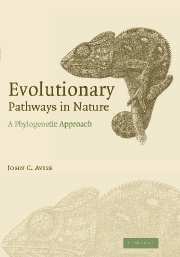Book contents
- Frontmatter
- Contents
- Preface
- Acknowledgments
- 1 Introduction
- 2 Anatomical structures and morphologies
- 3 Body colorations
- 4 Sexual features and reproductive lifestyles
- 5 More behaviors and ecologies
- 6 Cellular, physiological, and genetic traits
- 7 Geographical distributions
- Epilog
- Appendix: a primer on phylogenetic character mapping
- Glossary
- References and further reading
- Index
4 - Sexual features and reproductive lifestyles
Published online by Cambridge University Press: 18 December 2009
- Frontmatter
- Contents
- Preface
- Acknowledgments
- 1 Introduction
- 2 Anatomical structures and morphologies
- 3 Body colorations
- 4 Sexual features and reproductive lifestyles
- 5 More behaviors and ecologies
- 6 Cellular, physiological, and genetic traits
- 7 Geographical distributions
- Epilog
- Appendix: a primer on phylogenetic character mapping
- Glossary
- References and further reading
- Index
Summary
Nowhere is the biological world more interesting, flamboyant, and sometimes devious than it is with regard to sexual traits and reproductive activities. Procreation is the name of the evolutionary game, and organisms have discovered seemingly endless ways to transmit copies of their genes successfully to subsequent generations. Thus, species display an amazing variety of procreative adaptations and reproductive lifestyles whose geneses and historical interconversions are of special interest. Case studies highlighted in this chapter illustrate how PCM analyses have contributed to scientific understandings of the evolutionary transformations involving a variety of organismal characteristics directly related to reproduction, such as parthenogenesis (virgin birth), male pregnancy, egg laying, egg dumping, live bearing, delayed implantation, nest construction, brood care, and foster parentage. The PCM approach has even provided one definitive answer to the proverbial question: which came first, the chicken or the egg?
The chicken or the egg?
A chicken's egg is a rather amazing reproductive contraption: tapered at one end so that it can't easily roll out of the nest; just large enough to provision an embryo with adequate nutrients yet small enough to pass through a hen's cloaca (vaginal opening); and covered with a protective calcareous shell that can withstand the weight of an incubating parent but none the less is fragile enough to permit an emerging chick to peck its way free. Inside an egg's hard casing are all the biological paraphernalia necessary to support and nourish a developing embryo.
- Type
- Chapter
- Information
- Evolutionary Pathways in NatureA Phylogenetic Approach, pp. 77 - 113Publisher: Cambridge University PressPrint publication year: 2006



